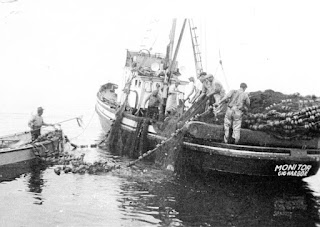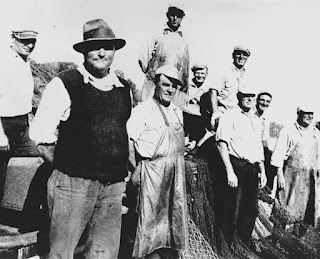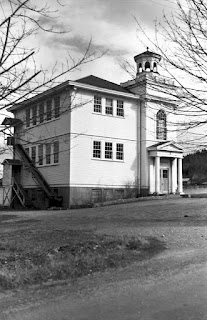Out of the Past: The Monitor: a fond remembrance
By Lee Makovich
October 1994
 |
| Spiro Janovich |
While in the old country Spiro Janovich had been a sailor in the Austrian Navy. Upon coming to America he went to work for Hunt Transportation Company of Gig Harbor, Washington as a skipper on several of the small vessels of the Hunt mosquito fleet. Janovich also became somewhat involved in the commercial fishing business.
In 1915 Janovich believed the time had come to take the big gamble: a total commitment to become fully involved in the salmon fishing business on the Puget Sound. Spiro knew the risks were great, but felt if he was going to take the chance he might as well go all out and build a brand new fishing boat.
Spiro talked to his friend John A. Martinolich of the Martinolich shipyard in Doctor, on Vashon Island, Washington about building a 58-foot seiner at the yard. Janovich was stunned to learn of the amount of investment that would be required to have his plans become a reality.
When Martinolich suggested a figure of about $4500 to complete the new vessel, Janovich knew he would have to do a bit of creative maneuvering to come up with that staggering amount of money. After all he had just recently purchased an acre of downtown Gig Harbor view property for a whopping $150. “Money doesn’t grow on trees you know,” Janovich was quoted as saying.
 |
| "Monitor" |
Consequently Janovich took in two partners in order to get the project off the ground. George Dorotich and Priscilla Johnson helped finance the completion of the new vessel which Spiro christened the Monitor. Dorotich and Johnson were involved in the new vessel for a short time but their interest was subsequently taken over by Janovich shortly after the end of the 1915 fishing season.
The Monitor must have been quite an impressive vessel in her day. She was a sleek 58 feet and powered by a “state of the art” three byliner 40 h.p. Frisco Standard gasoline engine.
Several other vessels were completed at the Martinolich yard in 1915. Among them were the 67-foot Chomly built for Alaska Pacific Fisheries, the 56-foot St John built for Pasco Dorotich, the 54-foot Elmer built for Sam Mezich, and the San Marco also 54-feet long, built for John Malich, Sr.
Mr. Janovich operated the Monitor in Puget Sound for many years, ran her to Southeast Alaska, and at one point took her down the coast to Oregon and fished for salmon on the Columbia River. The Monitor remained in the Janovich family for over 42 years until she was sold to the PeliganPacking Company of Peligan, Alaska in 1957.
 |
| Spiro Janovich and his crew |
Early on Spiro operated the Monitor himself, but in the later years he began to divide his time between running his boat and working for the Skansie Transportation Company, as First Mate on various ferry boats on the Gig Harbor/Tacoma run.
When the first Narrows Bridge collapsed in 1940 the ferry boats were rushed back into service. That, along with the start of World War II, found Janovich unable to leave his duties aboard the ferry boats. As a consequence he had a number of other skippers run the Monitor for him during the fishing season.
In 1941, John Stanich had his boat the Welcome engaged in dragging off the Washington Coast and ran the Monitor in the San Juans Islands for Spiro that summer. In 1942 Marion Covich had a similar situation with his Favorite, and operated the Monitor that year. Paul Puratich ran her the next year and Covich was back again in 1944.
When Marion Covich approached Janovich about running the Monitor in 1944, Janovich agreed to have Covich skipper the vessel on one condition: that Covich would take Spiro’s oldest son Tony along as a crew member. Tony Janovich remembered, “Covich was a top notch skipper and had a very experienced crew of his own. He certainly didn’t want a greenhorn 16 year old kid on his crew, but eventually found he had no choice in the matter. That turned out to be my first year as a regular crewman on a fishing boat.”
 |
| Tony, Spiro and George Janovich |
Tony found the experience of fishing with a top skipper like Marion Covich to be a great learning opportunity, although it may have been lost on his young age. Tony reminisced, “But how much can a 16 year old learn? I learned which end of the boat went down the bay first, but that was about it. I wish I could have had a little more experience before fishing with Covich. I certainly could have learned a lot more.”
“I remember an occasion near the end of the 1944 season. We were at Point Roberts and were having some problems with the old Frisco Standard engine. It started knocking and lost most of it’s power. Suddenly fish began showing up ahead of us. The other boats were going a lot faster than we were able to go, and by the time we got there the other boats were already in a haul. Covich kept the boat knocking and chugging ahead until we reached the school. There was no way we could get ahead of the fish so Covich set on their tails, a backward haul. I thought he was making a big mistake. Quite a mistake all right, we loaded the Monitor down with sockeye in that haul.”
The engineer and crew suspected a damaged crank shaft was responsible for the engine problems, but later learned it was “merely” a loose fly wheel. Tony said, “We did a little precision tuning on the engine with a sledge hammer, driving the flywheel key into the shaft more solidly. We had no further trouble with the old Frisco Standard after that.”
In the early 1940’s Frank “Kecko” Martinis took the Monitor out as a tender during the fall season. Tony remarked that the experience was rather uneventful except for a couple of mishaps such as running into a dock at Vashon Island in the fog, and going high and dry near Old Tacoma, Washington. “When we hit the docket Vashon, we sort of glanced off of it and ran up on shore,” Tony recalled. “There were trees and branches hanging all over the boat, but once we managed to hack our way out of the woods, the Monitor was undamaged.”
A year or so later, Angelo Susan leased the Monitor to go out after dogfish in Puget Sound during the winter. Tony said, “I sort of went along for the ride. I don’t recall catching any dogfish, but I do recall running aground near Dungeness one evening. A large steamer went by while we were stuck on the beach. I thought the waves it was making would pound the boat to pieces by fortunately that didn’t happen and we got out of there with no damage.”
I recall an incident in the mid 1940s when Tony and his brother George Janovich were moving the Monitor from a piling in the bay, to the fishermen’s dock in Gig Harbor. The Monitor’s Frisco Standard engine had not yet been equipped with pilot house controls. Tony was on the pilot house and I was down in the engine watching George answer the bell commands from Tony. Suddenly the bells began ringing like crazy. George became a little confused and there was a tremendous jolt as the Monitor bounced off the fishermen dock and sailed out into the middle of the bay.
As was always the case with the Janovich brothers (who are truly very close I might add) there came a great shouting and fist waving episode which lasted fully about 30 seconds, followed by uncontrollable laughter from everyone, which lasted a good deal longer.
The Monitor was repowered with a 150 h.p. Cummings diesel in 1945. In 1947 new bulwarks were added at the Glein Shipyard in Gig Harbor, and in 1948 the Monitor received a complete new pilot house at the same yard.
Tony Novak skippered the Monitor in 1945 and Spiro was able to leave his position on the ferries after the war. He returned to running his own boat for the 1946 and 1947 sessions. Early in 1948 Spiro Janovich became seriously ill and was unable to continue in the fishing business any longer.
Tony said, “In the spring of 1948, out of the blue, my mother said to me, ‘You’re taking the boat this year.’ I said, ‘Taking it where?’ It finally dawned on me she meant I was going to be running the Monitor that summer.”
Tony Janovich is a very modest man, never one to take himself too seriously. He said, “When my mother told me I was going to run the boat, if I’d had any brains I probably would have been scared to death; but I wasn’t. It was no big deal I thought, I can do it.”
A little reconsideration of that thought may have occurred when Tony realized, “I didn’t have the slightest idea of how to hang the net, how much web to put in and so forth.” Spiro had become too ill to help and Tony found himself asking some of the old timers for advice. In those days the art of hanging a seine to assure it’s greatest efficiency was a closely guarded secret, and sometimes still is.
“When I asked some of the old timers how much web I needed to put in per fathom, for example,” Tony said, “They would gesture with their hands to indicate an amount anywhere from three inches to three feet and say, ‘Oh you know, about this much or so.’ They were basically telling me to go and figure it out for myself.”
Tony remarked, “Either by accident or by instinct, I managed to make a net that worked just great that first year. I remember when I realized that the net was fine, it was a tremendous relief.”
A few years later Tony had some serious problems with a net he made. “We had used some sisal rope as we were unable to get a better quality of rope because of a shortage,” Tony said. “The sisal rope stretched giving us a lot of problems. That rope shouldn’t have been used on a net. It was much better suited for typing up cows or something.”
In the fall of 1949, Mike Galligan Sr., current owner of the seiner Margaret J., and I were in the skiff together, as two raw greenhorn crewmen with Tony aboard the Monitor. There were no radios in the skiff in those day and the Monitor’s whistle was not operating. Tony had started a haul in Colvos passage and Mike and I were towing our end of the net at full speed near the shore. We were blissfully singing songs and laughing while towing away, when suddenly Mike noticed Tony waving his arms frantically, like a giant bird in flight. “I wonder why he’s doing that?” Mike asked. “Is he trying to signal us?” I looked and said, “Who knows, maybe he’s trying to tell us there are some sea gulls coming our way and we should watch out so they don’t deposit on our heads.”
This explanation seemed to make sense to Mike and we continued blissfully towing away. In a moment we saw Tony throwing a dish, a coffee cup and some ranger overboard and waving his arms even more frantically. We both thought “What’s going on here?” In another moment we noticed that the cork line we were towing began passing us up and that the Monitor was running for the skiff, full bore, on a long towline.
With the wisdom of two Albert Einsteins, Mike and I finally realized why Tony was so upset; we had towed our end of the net onto a snag. When the Monitor got closer, the words coming from the pilot house should not have been heard by anyone not old enough to vote.
Suffice it to say, Mike Galligan and I were not very popular young fellows on the dock that evening as the entire crew had to work until almost morning to repair nearly 100 fathoms of net that was damaged. Tony was, shall we say, a little tense with Mike and I that evening, but by the next day all was forgotten and forgiven.
Tony Janovich was the skipper of the Monitor for nearly 10 years, until she was sold in 1957. Tony ran a number of boats after that including the Halo, Wawa, the Gary Denn, the Parks # 11, the Congress, the Pacific Breeze, the Pacific II, the Kathy H. and the St. Mary.
Tony purchased the 58-foot seiner Barbara S. from the New England Fish Company in 1959 and seined with her for a number of years, also taking her king crabbing out of Kodiak, Alaska for three seasons. The Barbara S. was sold in 1965.
The 65-foot seiner Shenandoah, formerly owned by John Dorotich who passed away in 1965, was purchased by Tony from Dorotich’s sister Lena Bez, in 1967. Tony still owns and operates the Shenandoah in the San Juan Islands every summer. He of course would never say it, but Tony is aware that he is considered one of the top skippers in the fishing business today.
It was great fun to reminisce about all of the amusing events that took place aboard the old Monitor over the years, but as we all know it is never all fun and games. There were tough times, hardships and problems that had to be met.
Spiro Janovich, like his son Tony, met all of those challenges and I guess, so did the old Monitor. She’s still going up in Alaska; still floating, still doing the job Spiro had intended for her when she was launched in 1915.
Like many other great ladies the Monitor has aged gracefully. One would never suspect she’s going on 80 now. We should all be so fortunate.
© 2012 Harbor History Museum. All rights reserved.





